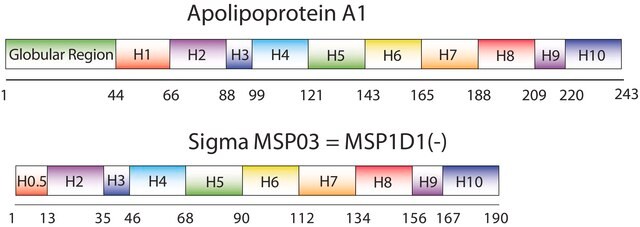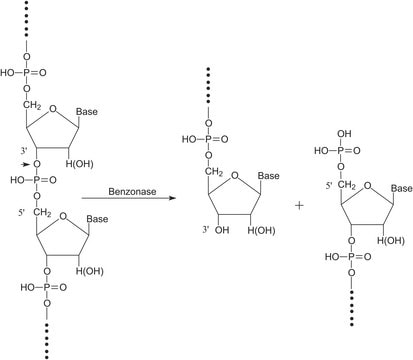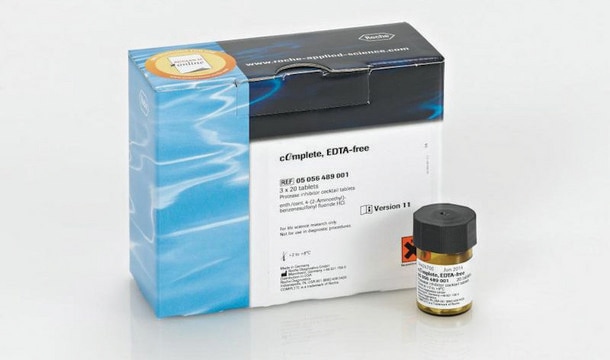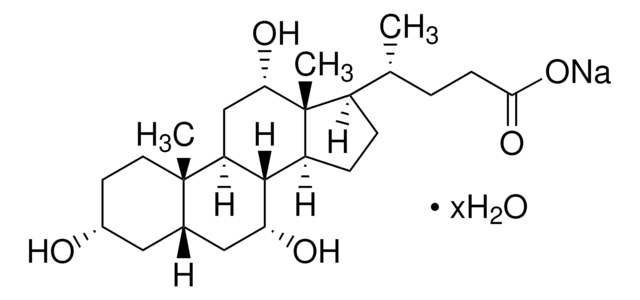추천 제품
생물학적 소스
microbial
Quality Level
재조합
expressed in E. coli
설명
N-Terminal histidine-tagged
양식
lyophilized powder
분자량
Mw 24661.9 by amino acid sequence
ε (흡광계수)
18200 M-1cm-1 at 280 nm (His-tag-cleaved dissolved in 20 mM Tris pH 7.4, 0.1M NaCl, 0.5mM EDTA and 0.01%NaN3)(lit.)
21000 M-1cm-1 at 280 nm (uncleaved His-tagged dissolved in 20 mM Tris pH 7.4, 0.1M NaCl, 0.5mM EDTA and 0.01%NaN3)(lit.)
저장 온도
−20°C
유사한 제품을 찾으십니까? 방문 제품 비교 안내
애플리케이션
For an extensive list of citations and protocols visit the Sligar Lab Website at; sligarlab.life.uiuc.edu/nanodisc.html
For guidelines on the use of this and other MSP′s to prepare Nanodiscs, please visit our Protocols for Membrane Scaffold Proteins and Nanodisc Formation page.
Membrane Scaffold Protein 1D1 has been used as a scaffolding protein to stabilize lipid nanodiscs (NDs). It has also been used for the preparation of nanodiscs.
Nanodisc soluble lipid bilayer systems have proven to be a widely applicable means for rendering membrane proteins soluble in aqueous solutions in a native-like bilayer environment where they remain monodisperse and active. The critical component of nanodiscs is the encircling amphipathic helical protein belt (membrane scaffold protein).
The nanodisc system has been employed to incorporate a wide variety of proteins including GPCRs, P450s, bacteriorhodopsin, coagulation factors, cholera toxin, TAR receptor and aromatase.
생화학적/생리학적 작용
Generates Nanodiscs ~9.7 nm in diameter
Membrane scaffold protein 1D1 (MSP1D1) is derived from apolipoprotein A-I. It is an amphipathic synthetic protein, which self assembles to form nanodiscs.
물리적 특성
Sequence:GHHHHHHHDYDIPTTENLYFQGSTFSKLREQLGPVTQEFWDNLEKETEGLRQEMSKDLEEVKAKVQPYLDDFQKKWQEEMELYRQKVEPLRAELQEGARQKLHELQEKLSPLGEEMRDRARAHVDALRTHLAPYSDELRQRLAARLEALKENGGARLAEYHAKATEHLSTLSEKAKPALEDLRQGLLPVLESFKVSFLSALEEYTKKLNTQ
물리적 형태
Supplied as a lyophilized histidine-tagged protein with a TEV protease cleavage site stabilized with Tris-HCl, EDTA, and NaCl.
법적 정보
Nanodisc technology, and many of its uses, are covered by the following patents held by the University of Illinois.
- 7,691,414 Membrane scaffold proteins
- 7,662,410 Membrane scaffold proteins and embedded membrane proteins
- 7,622,437 Tissue factor compositions and methods
- 7,592,008 Membrane scaffold proteins
- 7,575,763 Membrane scaffold proteins and tethered membrane proteins
- 7,083,958 Membrane scaffold proteins
- 7,048,949 Membrane scaffold proteins
관련 제품
제품 번호
설명
가격
신호어
Warning
유해 및 위험 성명서
예방조치 성명서
Hazard Classifications
Eye Irrit. 2 - Skin Irrit. 2 - STOT SE 3
표적 기관
Respiratory system
Storage Class Code
11 - Combustible Solids
WGK
WGK 3
Flash Point (°F)
Not applicable
Flash Point (°C)
Not applicable
이미 열람한 고객
Time-course and degradation rate of membrane scaffold protein (MSP1D1) during recombinant production
Faas R, et al.
Biotechnology reports (Amsterdam, Netherlands), 17, 45-48 (2018)
Lipid nanotechnologies for structural studies of membrane-associated proteins
Stoilova-McPhie S, et al.
Proteins: Structure, Function, and Bioinformatics, 82(11), 2902-2909 (2014)
Lipid nanotechnologies for structural studies of membrane-associated proteins.
Stoilova-McPhie, S., et al.
Proteins: Structure, Function, and Genetics, 82(11), 2902-2909 (2014)
Synaptosomes (2018)
Tomasz Uchański et al.
Nature methods, 18(1), 60-68 (2021-01-08)
Nanobodies are popular and versatile tools for structural biology. They have a compact single immunoglobulin domain organization, bind target proteins with high affinities while reducing their conformational heterogeneity and stabilize multi-protein complexes. Here we demonstrate that engineered nanobodies can also
문서
Read our article about how the Nanodisc system allows for structural studies of membrane proteins.
프로토콜
Protocols for Membrane Scaffold Proteins and Nanodisc Formation
자사의 과학자팀은 생명 과학, 재료 과학, 화학 합성, 크로마토그래피, 분석 및 기타 많은 영역을 포함한 모든 과학 분야에 경험이 있습니다..
고객지원팀으로 연락바랍니다.















